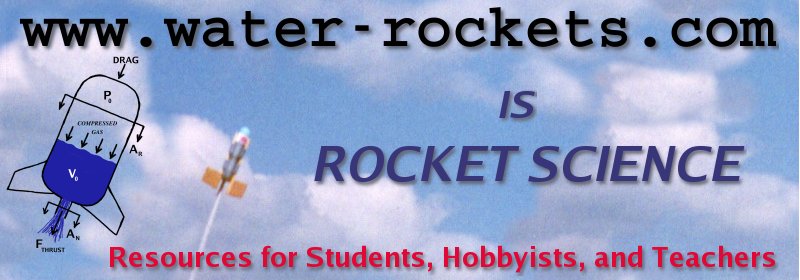
Tue Jul 15 20:46:52 2025 GMT
Safety First!Water rockets are fun and educational, but if not taken seriously could pose a safety risk. Having fun and learning cool science is the goal, so let's put safety first and make sure we don't hurt ourselves or others. Towards this end, water-rockets.com endorses the Water Rocket Safety Code as developed by Bruce Berggren. This Code is well thought-out and should keep you safe, however you are still responsible for your own safety.Think SAFETY, take precautions, and be safe! |
||||||||||
Water Rocket Safety Code2. Scope. This code applies to water rockets having a pressure chamber volume greater than 1200ml or a launch pressure exceeding 35 psi. 3. Materials. The pressure chamber of the rocket shall be constructed of thin, ductile plastic. Only lightweight, non-metal parts shall be used for the nose, body, and fins. 4. Compressed Gas Safety. A safe distance shall be maintained at all times between persons and pressurized water rockets or launchers. The recommended safe distance is as follows:
5. Pressurization System. Compressed air tanks and gas cylinders shall be stored and transported in accordance with all applicable safety codes. Line fittings near the operator shall be rated by the manufactuer for use with compressed gas at the intended pressure. 6. Launcher. The launcher shall hold the rocket to within 30 degrees of vertical to ensure that it flies nearly straight up. It shall provide a stable support against wind and any triggering forces, and allow the rocket to be pressurized and depressurized from a safe distance. Launchers shall be constructed from materials rated for at least 3 times the intended launch pressure. 7. Launch Safety. I will use a countdown prior to launch to ensure that spectators are paying attention and are a safe distance away. If my rocket does not launch when triggered, I will not allow anyone to approach it until it has been depressurized. 8. Size. A water rocket whose mass (excluding water) exceeds 453 grams (1 lb) shall be considered a “Large Model Rocket” for the purpose of compliance with Federal Aviation Administration regulations. 9. Flight Safety. Water rockets shall not be directed at targets, into clouds, or near airplanes. Flammable or explosive payloads shall not be carried. 10. Launch Site. Water rockets shall be launched outdoors, in an open area at least 100 feet on a side (for rockets with using a launch pressure of 60 psi or less), or 500 feet on a side (for rockets using higher pressure). 11. Recovery System. A recovery system such as a streamer, parachute, or tumble recovery shall be used, with the intent to return it safely to earth without damage. 12. Recovery Safety. Recovery shall not be attempted from power lines, tall trees, or other dangerous places. |
||||||||||
| updated 12-APR-2009 | ||||||||||
for more information see:

Question? Comment? Send A Message

216.73.216.236